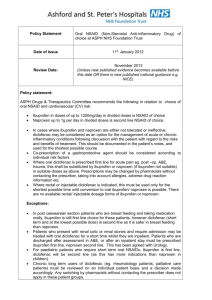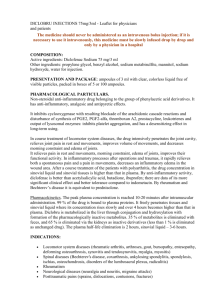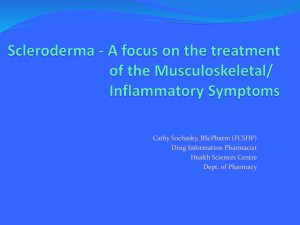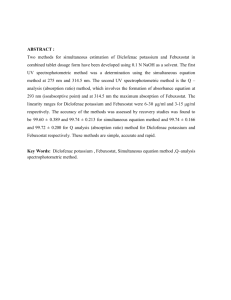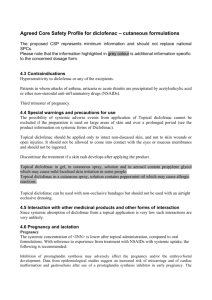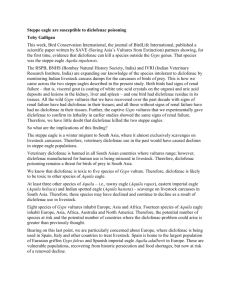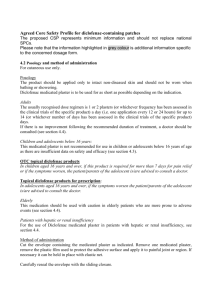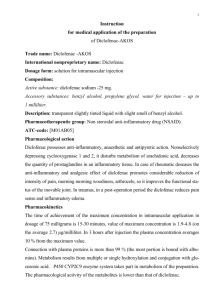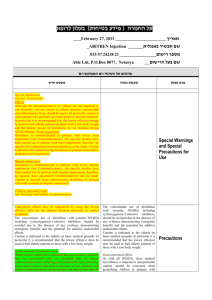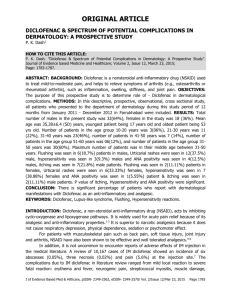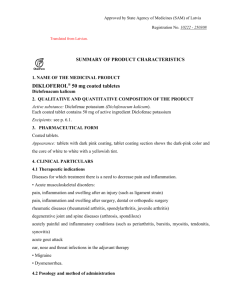Tablet Press Extra NSAIDS Dec 2007
advertisement
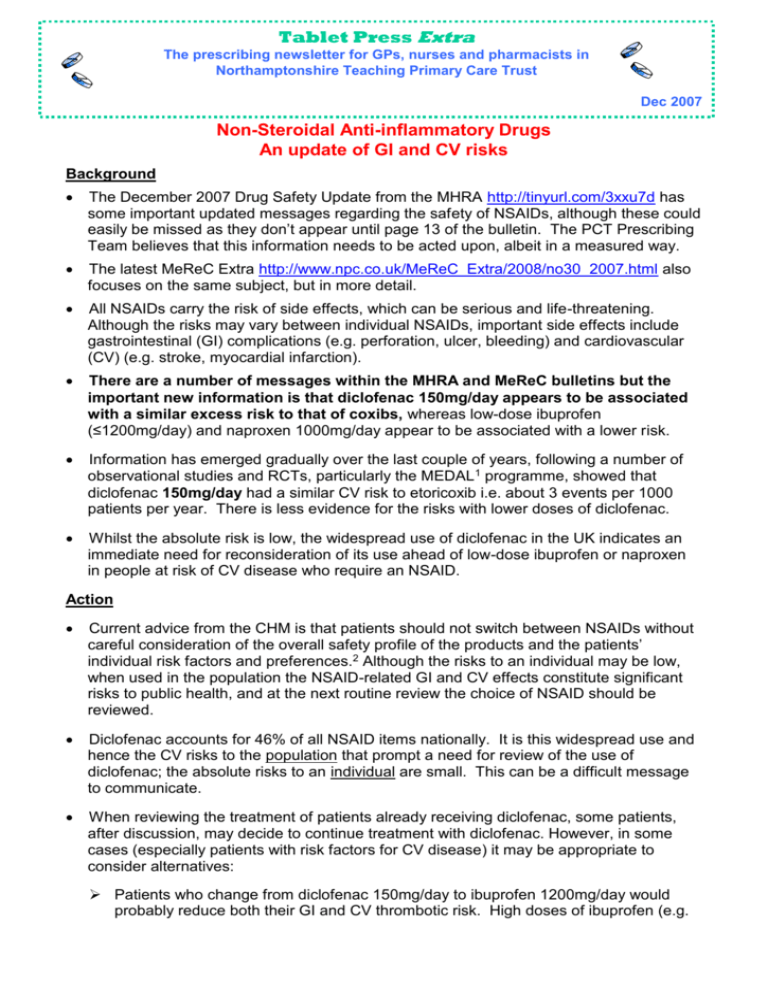
Tablet Press Extra The prescribing newsletter for GPs, nurses and pharmacists in Northamptonshire Teaching Primary Care Trust Dec 2007 Non-Steroidal Anti-inflammatory Drugs An update of GI and CV risks Background The December 2007 Drug Safety Update from the MHRA http://tinyurl.com/3xxu7d has some important updated messages regarding the safety of NSAIDs, although these could easily be missed as they don’t appear until page 13 of the bulletin. The PCT Prescribing Team believes that this information needs to be acted upon, albeit in a measured way. The latest MeReC Extra http://www.npc.co.uk/MeReC_Extra/2008/no30_2007.html also focuses on the same subject, but in more detail. All NSAIDs carry the risk of side effects, which can be serious and life-threatening. Although the risks may vary between individual NSAIDs, important side effects include gastrointestinal (GI) complications (e.g. perforation, ulcer, bleeding) and cardiovascular (CV) (e.g. stroke, myocardial infarction). There are a number of messages within the MHRA and MeReC bulletins but the important new information is that diclofenac 150mg/day appears to be associated with a similar excess risk to that of coxibs, whereas low-dose ibuprofen (≤1200mg/day) and naproxen 1000mg/day appear to be associated with a lower risk. Information has emerged gradually over the last couple of years, following a number of observational studies and RCTs, particularly the MEDAL1 programme, showed that diclofenac 150mg/day had a similar CV risk to etoricoxib i.e. about 3 events per 1000 patients per year. There is less evidence for the risks with lower doses of diclofenac. Whilst the absolute risk is low, the widespread use of diclofenac in the UK indicates an immediate need for reconsideration of its use ahead of low-dose ibuprofen or naproxen in people at risk of CV disease who require an NSAID. Action Current advice from the CHM is that patients should not switch between NSAIDs without careful consideration of the overall safety profile of the products and the patients’ individual risk factors and preferences.2 Although the risks to an individual may be low, when used in the population the NSAID-related GI and CV effects constitute significant risks to public health, and at the next routine review the choice of NSAID should be reviewed. Diclofenac accounts for 46% of all NSAID items nationally. It is this widespread use and hence the CV risks to the population that prompt a need for review of the use of diclofenac; the absolute risks to an individual are small. This can be a difficult message to communicate. When reviewing the treatment of patients already receiving diclofenac, some patients, after discussion, may decide to continue treatment with diclofenac. However, in some cases (especially patients with risk factors for CV disease) it may be appropriate to consider alternatives: Patients who change from diclofenac 150mg/day to ibuprofen 1200mg/day would probably reduce both their GI and CV thrombotic risk. High doses of ibuprofen (e.g. 2400mg/day) are not prescribed frequently in clinical practice, and the relative risks versus diclofenac are unclear. Patients who change from diclofenac 150mg/day to naproxen 1000mg/day would reduce their CV thrombotic risk, but may slightly increase their risk of GI complications. However, if the opportunity is taken to introduce a PPI (omeprazole 20mg od), the GI risks may also be reduced. There is less evidence for the balance of risks with lower doses of diclofenac and naproxen. We strongly advise all clinicians to read both the MHRA bulletin and the MeReC Extra to get a fuller perspective on this issue. We also advise that you listen to the NPCi podcast on this subject, which lasts about 20 minutes and puts the individual and population risks into perspective very well. http://www.npci.org.uk/podcast/ The PCT Prescribing Team has long seen the appropriate use of NSAIDs as a priority; a lot of work has been done on this area over a number of years and NSAIDs cover 2 of the 15 markers in the Prescribing Incentive Scheme. The PCT is consequently a very low user of NSAIDs compared to national. The Prescribing Team is already working on a strategy of how best to put this new information into practice. The early message is that any changes to patients’ NSAIDs should be done on an individual patient basis - it is definitely NOT appropriate to undertake mass switch programs in this situation. The individual risks (both CV and GI) and benefits must be considered for each patient. The Prescribing Team will be supporting practices with audits and patient information, where needed, which will be available in January. We will take the opportunity to look again at overall NSAID use in addition to the diclofenac issues. The Prescribing Team will be happy to help with any patient queries that may arise next week and we hope this Tablet Press Extra will be useful to you in this context. Sue Smith, Associate Director Pharmacy Policy and Prescribing, 01536 480445 sue.smith@northants.nhs.uk Or Giles Owen, Deputy Head of Pharmacy Policy and Prescribing, 01536 480446 Giles.owen@northants.nhs.uk Or contact your locality Prescribing Adviser. 1 Cannon CP, Curtis SP, FitzGerald GA, et al. Cardiovascular outcomes with etoricoxib and diclofenac in patients with osteoarthritis and rheumatoid arthritis in the Multinational Etoricoxib and Diclofenac Arthritis Long-term (MEDAL) programme: a randomised comparison. Lancet 2006;368:1771–81 2 Duff G. Chaiman, Commission of Human Medicines. Safety of selective and non-selective NSAIDs. Letter. October 2006 This edition is also available on HNN (Health Network Northants) http://nww.northants.nhs.uk/Display/Dynamic.jsp?topid=14070&lhsid=514&oid=2854&currentid=2854 Disclaimer Information in this newsletter is believed to be accurate and true. Northamptonshire PCT and its employees accept no liability for loss of any nature, to persons, organisations or institutions that may arise as a result of any errors or omissions. Contact No 01536 480446
